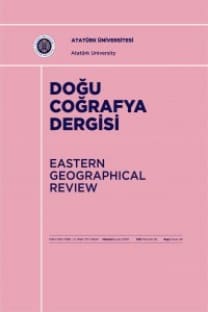Üniversite öğrencilerinin “çevre” kavramına ilişkin metaforik algıları
The metaphoric perceptions of university students towards “environment” concept
___
- ALGER, C. (2009). Secondary Teachers' Conceptual Metaphors of Teaching and Learning: Changes over the Career Span. Teaching and Teacher Education: An International Journal of Research and Studies, 25(5), 743-751.
- ARSLAN, M.M. ve BAYRAKÇI, M. (2006). Metaforik Düşünme ve Öğrenme Yaklaşımının Eğitim-Öğretim Açısından İncelenmesi. Millî Eğitim, 35(171), 100-108.
- ATALAY, İ. (2004). Doğa Bilimleri Sözlüğü, İzmir: Meta Basımevi.
- AYDIN, F. (2010). Ortaöğretim Öğrencilerinin Coğrafya Kavramına İlişkin Sahip Oldukları Metaforlar. Kuram ve Uygulamada Eğitim Bilimler Dergisi (KUYEB), 10(3), 1313-1322.
- AYDIN, F. ve ÜNALDI ESER, Ü. (2010). Coğrafya Öğretmen Adaylarının Coğrafya Kavramına İlişkin Algılarının Metaforlar Yardımıyla Analizi. International Online Journal of Educational Sciences (IOJES), 2(2), 600-622.
- BİLGİ, M.G. (2008). Ortaöğretim Kurumlarında Coğrafya Dersi Kapsamındaki Çevre Konularının Öğretiminde Aktif Öğretim Yöntemlerinin Rolü. Yayınlanmamış Doktora Tezi. Gazi Üniversitesi, Eğitim Bilimleri Enstitüsü
- BOTHA, E. (2009). Why metaphor matters in education. South African of Education, 29, 431-444.
- CERİT, Y. (2008). Öğretmen Kavramı ile İlgili Metaforlara İlişkin Öğrenci, Öğretmen ve Yöneticilerin Görüşleri. Türk Eğitim Bilimleri Dergisi, 6(4), 693-712.
- COŞKUN, M. (2010). Lise Öğrencilerinin “iklim” Kavramıyla İlgili Metaforları (Zihinsel İmgeleri). Turkish Studies International Periodical For the Languages, Literature and History of Turkish or Turkic. 5(3), 919-940.
- ÇEPNİ, S. (2007). Araştırma ve proje çalışmalarına giriş. Trabzon: Celepler matbaacılık.
- DEMİRKAYA, H. (2006). Çevre Eğitiminin Türkiye’deki Coğrafya Programları İçerisindeki Yeri ve Çevre Eğitimine Yönelik Yeni Yaklaşımlar. Fırat Üniversitesi Sosyal Bilimler Dergisi, 16(1), 207-222.
- DEMİRKAYA, H., MUTLU, M. ve UŞAK, M. (2003). 4MAT Öğretim Sistem Modeli’nin Çevre Eğitimine Uygulanması. Pamukkale Üniversitesi Eğitim Fakültesi Dergisi, 14, 68-82.
- DOĞANAY, H. (1993). Coğrafya’ya Giriş. Erzurum: Aktif Yayınları.
- EFE, R. (2002). Coğrafyada Beş Temel Kavram ve Bunların Öğretim Metot ve Teknikleri. Marmara Coğrafya Dergisi, 5, 27-42.
- FORCEVİLLE, C. (2002). The İdentification of Target and Source in Pictorial Metaphors. Journal of Pragmatics, 34, 1-14.
- GİRMEN, P. (2007). İlköğretim Öğrencilerinin Konuşma ve Yazma Sürecinde Metaforlardan Yararlanma Durumları. Yayımlanmamış Doktora Tezi, Anadolu Üniversitesi, Eğitim Bilimleri Enstitüsü, Eskişehir.
- GUERRERO, M. C. M. ve Villamil, O.S. (2002). Metaphorical Conceptualizations of Els Teaching and Learning. Language Teaching Research, 6(2), 95-120.
- GÜNEY, E. (2004). Çevre Sorunları Coğrafyası. Ankara: Gündüz Eğitim ve Yayıncılık.
- INBAR, D. (1996). The Free Educational Prison: Metaphors and İmages. Educational Research, 38(1), 77-92.
- KAYA, H. (2010). Metaphors Developed by Secondary school students towards “earthquake” Concept. Educatioanl Research and Review, 5(1), 712-718.
- KAYA, H., COŞKUN, M. ve AYDIN, F. (2010). The Analysis of High School Studenst’s Perceptions Towards “Environmen” Concept. African Journal of Agricultural Research, 5(13), pp:1591-1597.
- LAKOFF, G. ve JOHNSON, M. (2005). Metaforlar: Hayat, anlam ve dil (Çeviren: G.Y.Demir). İstanbul: Paradigma.
- LEVİNE, P.M. (2005). Metaphors and Images of Classrooms. ERIC Document: EJ724893.
- MARTON, F. (1986). Phenomenography: A research approach to investigating different understandings of reality. Journal of Thought, 2(3), 28-49.
- MİLES, M.B. ve HUBERMAN, A.M. (1994). Qualitative Data Analysis. Thousand Oaks, CA: Sage.
- MORGAN, G. (1998). Yönetim ve Örgüt Teorilerinde Metafor. İstanbul: Mess Yayınları.
- ÖNAL, H. (2008). Coğrafya Öğretiminde Aktif Öğrenme Uygulamaları. Yayınlanmamış Doktora Tezi. Gazi Üniversitesi, Eğitim Bilimleri Enstitüsü
- ÖZEY, R. (2001). Çevre Sorunları. İstanbul: Aktif Yayınevi.
- ÖZTÜRK, Ç. (2007). Sosyal Bilgiler, Sınıf Ve Fen Bilgisi Öğretmen Adaylarının “Coğrafya” Kavramına Yönelik Metafor Durumları. Ahi Evran Üniversitesi, Kırşehir Eğitim Fakültesi Dergisi, 8(2), 55-69.
- SABAN, A. (2004). Giriş Düzeyindeki Sınıf Öğretmeni Adaylarının “Öğretmen” Kavramına İlişkin İleri Sürdükleri Metaforlar. Türk Eğitim Bilimleri Dergisi, 2(2), 131-155.
- SABAN, A. (2008). İlköğretim I. kademe Öğretmen ve Öğrencilerinin Bilgi Kavramına İlişkin Sahip Oldukları Zihinsel İmgeler. İlköğretim Online, 7(2), 421-455.
- SABAN, A. (2009). Öğretmen Adaylarının Öğrenci Kavramına İlişkin Sahip Olduğu Zihinsel İmgeler. Türk Eğitim Bilimleri Dergisi, 7(2), 281-326.
- SABAN, A., KOÇBEKER, B.N. ve SABAN, A. (2006). Öğretmen Adaylarının Öğretmen Kavramına İlişkin Algılarının Metafor Analizi Yoluyla İncelenmesi. Kuram ve Uygulamada Eğitim Bilimleri (Educational Sciences: Theory & Practice) ,6(2), 461-522.
- SEMERCİ, Ç. (2007). “Program Geliştirme” Kavramına İlişkin Metaforlarla Yeni İlköğretim Programlarına Farklı Bir Bakış, Cumhuriyet Üniversitesi, Sosyal Bilimler Dergisi, 31(2), 125-140.
- SHAW, D., MASSENGİLL, B. ve MAHLİOS, M. (2008). Preservice Teachers' Metaphors of Teaching in Relation to Literacy Beliefs. Teachers and Teaching: Theory and Practice, 14(1), 35-50.
- TÖREMEN, F. ve DÖŞ, İ. (2009). İlköğretim Öğretmenlerinin Müfettişlik Kavramına İlişkin Metaforik Algıları. Kuram ve Uygulamada Eğitim Bilimleri (Educational Sciences: Theory & Practice), 9(4), 1973-2012.
- YILDIRIM, A. ve ŞİMŞEK, H. (2006). Sosyal Bilimlerde Nitel Araştırma Yöntemleri. Ankara: Seçkin Yayınevi.
- YOB I.M. (2003). Thinking Constructively with Metaphors. Studies in Philosophy and Education, 22, 127–138.
- ISSN: 1302-7956
- Yayın Aralığı: Yılda 2 Sayı
- Başlangıç: 1995
- Yayıncı: Prof.Dr. İbrahim Fevzi ŞAHİN
DOĞU KARADENİZ’DE YAYLA TURİZMİ MERKEZLERİNE YENİ BİR ÖRNEK: TAŞKÖPRÜ YAYLASI
Türkiye'de kiraz tarımının coğrafi esasları
SANDIKLI İLÇESİNDE DOĞAL YAPININ KIR YERLEŞMELERİ ÜZERİNDEKİ ETKİLERİ
EFLANİ İLÇESİ’NDE (KARABÜK) NÜFUS
Eflani ilçesi'nde (Karabük) nüfus
Üniversite öğrencilerinin “çevre” kavramına ilişkin metaforik algıları
Çal mağarası (Düzköy-Trabzon) ve çevresinin ekoturizm potansiyeli açısından önemi
